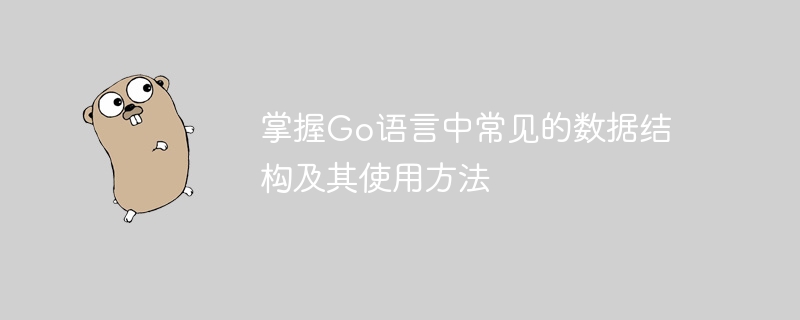Go 言語で一般的なデータ構造とそのメソッドの使用方法を学ぶ
- WBOYWBOYWBOYWBOYWBOYWBOYWBOYWBOYWBOYWBOYWBOYWBOYWBオリジナル
- 2024-01-09 17:02:301015ブラウズ

一般的なデータ構造とその使用法を Go 言語で習得するには、特定のコード例が必要です。
Go 言語では、データ構造はデータを整理して保存する方法です。方法。一般的なデータ構造とその使用方法をマスターすることは、効率的なプログラムを開発するために重要です。この記事では、Go 言語の一般的なデータ構造を紹介し、具体的なコード例を示します。
- 配列 (配列)
配列は、固定サイズの要素を格納するデータ構造です。 Go 言語では、配列の長さは不変です。
コード例:
package main
import "fmt"
func main() {
// 创建一个长度为5的整数数组
var arr [5]int
// 给数组赋值
for i := 0; i < len(arr); i++ {
arr[i] = i * i
}
// 打印数组的值
for _, value := range arr {
fmt.Println(value)
}
}- Slice (スライス)
Slice は Go 言語での動的配列の実装です。スライスの長さは動的に変更できます。
コード例:
package main
import "fmt"
func main() {
// 创建一个空切片
var slice []int
// 给切片添加元素
slice = append(slice, 1)
slice = append(slice, 2)
slice = append(slice, 3)
// 打印切片的容量和长度
fmt.Println("Capacity:", cap(slice))
fmt.Println("Length:", len(slice))
// 打印切片的值
for _, value := range slice {
fmt.Println(value)
}
}- リンク リスト
リンク リストは、データを格納するために使用される線形データ構造です。 Go 言語では、ポインターを使用してリンク リストを実装できます。
コード例:
package main
import "fmt"
type Node struct {
data int
next *Node
}
type LinkedList struct {
head *Node
}
func (list *LinkedList) add(data int) {
newNode := &Node{data: data}
if list.head == nil {
list.head = newNode
} else {
current := list.head
for current.next != nil {
current = current.next
}
current.next = newNode
}
}
func main() {
linkedList := &LinkedList{}
linkedList.add(1)
linkedList.add(2)
linkedList.add(3)
current := linkedList.head
for current != nil {
fmt.Println(current.data)
current = current.next
}
}- スタック (スタック)
スタックは後入れ先出し (LIFO) データ構造です。 Go 言語では、スライスを使用してスタックを実装できます。
コード例:
package main
import "fmt"
type Stack struct {
data []int
}
func (stack *Stack) push(value int) {
stack.data = append(stack.data, value)
}
func (stack *Stack) pop() int {
if len(stack.data) == 0 {
return -1
}
value := stack.data[len(stack.data)-1]
stack.data = stack.data[:len(stack.data)-1]
return value
}
func main() {
stack := &Stack{}
stack.push(1)
stack.push(2)
stack.push(3)
value := stack.pop()
for value != -1 {
fmt.Println(value)
value = stack.pop()
}
}- Queue (キュー)
Queue は先入れ先出し (FIFO) データ構造です。 Go 言語では、スライスを使用してキューを実装できます。
コード例:
package main
import "fmt"
type Queue struct {
data []int
}
func (queue *Queue) enqueue(value int) {
queue.data = append(queue.data, value)
}
func (queue *Queue) dequeue() int {
if len(queue.data) == 0 {
return -1
}
value := queue.data[0]
queue.data = queue.data[1:]
return value
}
func main() {
queue := &Queue{}
queue.enqueue(1)
queue.enqueue(2)
queue.enqueue(3)
value := queue.dequeue()
for value != -1 {
fmt.Println(value)
value = queue.dequeue()
}
}上記のコード例では、Go 言語の一般的なデータ構造とその使用方法について説明します。これらのデータ構造を学習して習得することで、プログラムの効率と可読性を向上させることができます。この記事がGo言語のデータ構造を学ぶのに役立つことを願っています。
以上がGo 言語で一般的なデータ構造とそのメソッドの使用方法を学ぶの詳細内容です。詳細については、PHP 中国語 Web サイトの他の関連記事を参照してください。
声明:
この記事の内容はネチズンが自主的に寄稿したものであり、著作権は原著者に帰属します。このサイトは、それに相当する法的責任を負いません。盗作または侵害の疑いのあるコンテンツを見つけた場合は、admin@php.cn までご連絡ください。

